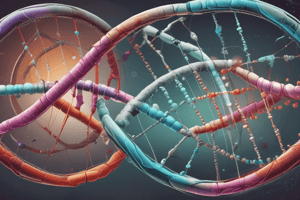Podcast
Questions and Answers
What is the term for the process by which DNA makes a copy of itself?
What is the term for the process by which DNA makes a copy of itself?
- Translation
- Transcription
- Mutation
- Replication (correct)
During DNA replication, what is the function of helicase?
During DNA replication, what is the function of helicase?
- To synthesize new strands of DNA
- To bind primers to template strands
- To unwind the double helix (correct)
- To proofread and edit new strands
What is the result of semi-conservative replication?
What is the result of semi-conservative replication?
- Each new DNA molecule contains two old strands
- Each new DNA molecule contains one old strand and one new strand (correct)
- Each new DNA molecule contains one old strand and one RNA strand
- Each new DNA molecule contains two new strands
What is the term for the process by which genetic information in DNA is used to synthesize RNA?
What is the term for the process by which genetic information in DNA is used to synthesize RNA?
During transcription, what is the function of RNA polymerase?
During transcription, what is the function of RNA polymerase?
What is the term for a change in the DNA sequence?
What is the term for a change in the DNA sequence?
What is the result of a point mutation?
What is the result of a point mutation?
What is the term for a change in chromosome structure or number?
What is the term for a change in chromosome structure or number?
What is a common cause of mutations?
What is a common cause of mutations?
What is the result of a frameshift mutation?
What is the result of a frameshift mutation?
Flashcards are hidden until you start studying
Study Notes
DNA Structure
Replication
- Process by which DNA makes a copy of itself
- Semi-conservative replication: each new DNA molecule contains one old strand and one new strand
- Steps:
- Unwinding of double helix by helicase
- Binding of primers to template strands
- Synthesis of new strands by DNA polymerase
- Proofreading and editing to correct errors
Transcription
- Process by which genetic information in DNA is used to synthesize RNA
- Steps:
- Binding of RNA polymerase to promoter region
- Unwinding of DNA double helix
- Synthesis of RNA complementary to template strand
- Termination of transcription
Mutation
- Change in the DNA sequence
- Types:
- Point mutation: substitution of a single nucleotide
- Frameshift mutation: insertion or deletion of nucleotides
- Chromosomal mutation: change in chromosome structure or number
- Causes:
- Errors during DNA replication
- Exposure to mutagenic agents (e.g. radiation, chemicals)
- Effects:
- Silent mutation: no effect on protein function
- Missense mutation: change in amino acid sequence
- Nonsense mutation: premature termination of protein synthesis
Chromatin
- Complex of DNA and proteins that make up chromosomes
- Structure:
- Nucleosome: DNA wrapped around histone proteins
- Chromatin fiber: series of nucleosomes
- Functions:
- Packaging of DNA into nucleus
- Regulation of gene expression
Histone
- Family of basic proteins that DNA wraps around to form chromatin
- Types:
- Histone H1: links nucleosomes together
- Histone H2A, H2B, H3, and H4: core histones
- Functions:
- Organization of DNA into chromatin structure
- Regulation of gene expression through histone modification (e.g. acetylation, methylation)
Studying That Suits You
Use AI to generate personalized quizzes and flashcards to suit your learning preferences.




